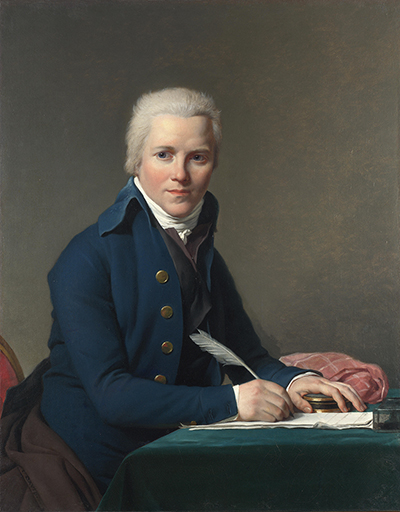Jacques Louis David produced a number of captivating portrait paintings in the year of 1795, one of which is displayed here. Jacobus Blauw played an important role in the development towards the creation of the single democratic state of the Netherlands.
We find this civic official dressed in a smart blue jacket, seemingly busy at work in his office. He holds a serious expression, suggesting a professional character who understood the importance of his occupation. It is likely that Blauw had commissioned David to produce this portrait whilst he was visiting Paris and could therefore have been aware of the painter's reputation before making the journey. The official is poised to sign some documents on a simple table covered in green velvet cover. He is perched on a red wooden chair and the background wall behind him is deliberately left without any significant detail in order to avoid distracting the viewer. The table also features some small writing equipment, such as perhaps a small inkwell. He has his left hand on another item, perhaps a seal, and there is also a checked cloth on the far edge of the table.
Wigs are sported by many of those modelling for this artist, due to their aristocratic backgrounds, but Jacobus Blauw is displaying only his own hair. Makeup was common for both genders at that time, though his overall appearance is still fairly simple and practical. He is clearly concentrated on the tasks at hand, rather than concerning himself with impressing others. This professional attitude is likely to have impressed David, though we still have an interest over why Jacobus Blauw chose to have his portrait painted by such a famous and respected artist. It may have been less about his own appearance, and more about recording a significant event that he had arrived in Paris to carry out. It was specifically the 1795 Treaty of The Hague which aimed to ensure peace between France and the Netherlands.
Blauw was someone who David saw ability within. He was a capable young man, not even forty at that point, but had risen to prominence through hard work and intelligence. This was the sort of situation that the artist approved of, and contrasted the inherited status that so many others had been gifted. There was a correspondence between the two after the painting was finished, even after Blauw had returned to the Netherlands to continue his new role. He told the artist of his great happiness with the completed work. The facial expression of the model would suggest that they already had become comfortable in each other's company whilst David put the artwork together.





